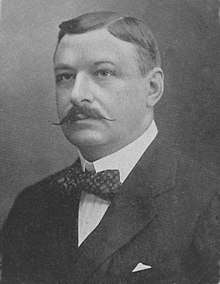George Musgrove
George Musgrove (21 January 1854 – 21 January 1916) was an English-born Australian theatre producer.
George Musgrove | |
|---|---|
 | |
| Born | 21 January 1854 Surbiton, England |
| Died | 21 January 1916 (aged 62) Sydney, New South Wales, Australia |
| Occupation | Theatre producer |
| Years active | 1880–1916 |
Early life
Musgrove was born at Surbiton, England, the son of Thomas John Watson Musgrove, an accountant, and his wife, Fanny Hodson, an actress and sister of Georgiana Rosa Hodson who married William Saurin Lyster. Fanny's brother was composer, singer and comedian George Alfred Hodson, the father of Henrietta Hodson, a well known London actress, who married Henry Labouchère.[1][2] Musgrove was brought to Australia by his parents in January 1863 when he was nine years old.[3] He was educated at the Flinders School, Geelong, Victoria, and on leaving school was given a position as treasurer by Lyster.[2] Musgrave married Emily Fisk Knight at All Saints Church, St Kilda, on 1 August 1874.[2]
Opera and theatre career
Musgrove visited England in 1879, a time when Gilbert and Sullivan had commenced their operas.[2] At the end of 1880, Musgrove produced La fille du tambour-major at the opera house, Melbourne, which had a record run of 101 nights. This success led the young producer to join a partnership with J. C. Williamson and Arthur Garner. They formed the Willamson, Garner and Musgrove Company in July 1882[4] when they became joint lessees of the Theatre Royals in Melbourne and Sydney. The partnership split in March 1890[5] with Williamson and Garner continuing to run the Theatre Royal in Melbourne along with the Princess Theatre and Musgrove taking control of the Theatre Royal, Sydney. Musgrove managed a successful season of Paul Jones with Marion Burton and Nellie Stewart in the leading parts. At the end of 1892, Williamson and Musgrove went into partnership again for about seven years, Musgrove living much of the time in London. In 1898 he brought a complete American company to the Shaftesbury Theatre, London, to play The Belle of New York, which had an enormous success.[1]
In 1900 Musgrove took a grand opera company to Australia, consisting mainly of artists from the Carl Rosa Opera Company with Gustave Slapoffski as the conductor, which performed Tannhäuser, The Flying Dutchman and many other well-known operas. In 1903 he was responsible for acclaimed productions of Shakespeare, played in several cities in Australia, including Twelfth Night, or What You Will, As You Like It, and A Midsummer Night's Dream. Also in 1903, he presented Nellie Melba in her first and most successful concert tour of Australia and New Zealand.[1]
In 1907 Musgrove produced a German grand opera company that introduced Die Walküre (The Valkyrie), Romeo and Juliet and Hänsel und Gretel to the Australian public, again under the baton of Gustave Slapoffski. Another opera season in 1909 was less successful. In his last years, Musgrove suffered from financial worries and poor health. Musgrove died suddenly at his home in Sydney on 21 January 1916, his sixty-second birthday.[2]
Personality and family
Musgrove could be brusque but was known as a kind-hearted, considerate employer of his artistes.[2] He was reputed to value artistic quality over profitability.[2] Musgrove's marriage produced two daughters, Emily Musgrove and Rose Musgrove, an actress in comedies and Edwardian musical comedies. His eldest daughter, Lily Musgrove, married Melbourne barrister Casimir Zichy-Woinarski in 1898.[6] His third daughter, Nancye Doris Stewart, was also known as Nancye Doris Lynton, (1893–1973), the child of his lover, actress and singer Nellie Stewart.[7]
His brother Harry Musgrove (c. 1861 – 2 November 1931) was also involved in theatre management. He had two sons, Harry[8] and Victor, and a daughter, actress Georgie Musgrove.[9] Harry George Musgrove (c. 1883 – 27 April 1951)[10] who, with E. J. Carroll and Dan Carroll, founded the magnificent Prince Edward Theatre on Castlereagh Street, Sydney, later bankrupt.[11]
References
- Serle, Percival (1949). "Musgrove, George". Dictionary of Australian Biography. Sydney: Angus and Robertson. Retrieved 3 October 2008.
- Gittins, Jean (1974). "Musgrove, George (1854 - 1916)". Australian Dictionary of Biography. Melbourne University Press. ISSN 1833-7538. Retrieved 1 November 2009 – via National Centre of Biography, Australian National University.
- Information obtained from the 1863 death certificate of his brother, Thomas John Watson Musgrove, held by the Department of Justice, Victoria, Australia
- reported in Amusements in Sydney, The Era, 18 March 1882; p. 9, col. C
- The Stage in Australia, Otago Witness, 6 March 1890; p. 36, col. B
- "Family Notices". The Argus (Melbourne) (16, 223). Victoria, Australia. 2 July 1898. p. 1. Retrieved 2 August 2020 – via National Library of Australia.
- Rutledge, Martha (1967). "Lynton, Nancye Doris (1893–1973)". Australian Dictionary of Biography. Melbourne University Press. ISSN 1833-7538. Retrieved 1 November 2009 – via National Centre of Biography, Australian National University.
- "Melbourne Notes". Critic. XXXI, (1204). South Australia. 23 March 1921. p. 18. Retrieved 2 August 2020 – via National Library of Australia.CS1 maint: extra punctuation (link)
- "Passing of Harry Musgrove". Mudgee Guardian And North-western Representative. New South Wales, Australia. 5 November 1931. p. 3. Retrieved 2 August 2020 – via National Library of Australia.
- "Ex-theatre man dies". The Daily Telegraph (Sydney). XVI, (31). New South Wales, Australia. 28 April 1951. p. 4. Retrieved 2 August 2020 – via National Library of Australia.CS1 maint: extra punctuation (link)
- "Theatre Man No Longer a Bankrupt". The Sydney Morning Herald (34, 154). New South Wales, Australia. 10 June 1947. p. 7. Retrieved 2 August 2020 – via National Library of Australia.